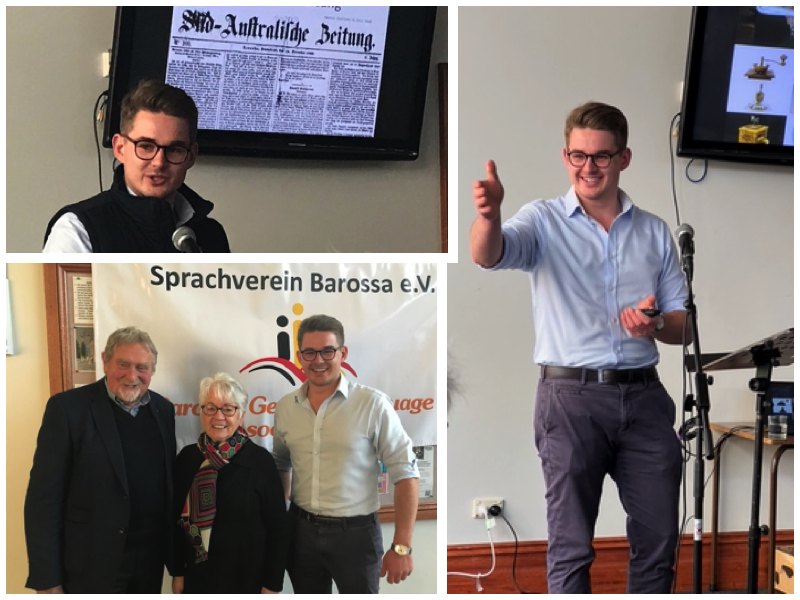A Story in Ten Objects
by John Clarke
Is it possible to represent the South Australian/German connection in ten objects?
That was the task historian Samuel Doering set himself as guest speaker at the last meeting of the German speaking group Kaffee und Kuchen.
First, appropriately for an audience brought together by the promise of coffee and cake, there was Rote Grütze. A sweet from Denmark and northern Germany Rote Grütze is traditionally made with whole summer berries and black cherries, but the Barossa Valley with its abundance of red wine grapes has developed its own distinct variety or varieties as makers of the sweet compete for the best Rote Grütze at local shows. The sweet represents the culinary delights that the German migrants brought to South Australia.
Second was the Kaffeemühle (coffee grinder), representative of the Germans’ Gemütlichkeit (friendship, warmth and well being). And in South Australia the coffee is often accompanied by a slice of Streuselkuchen (crumb cake).
Third was a newspaper, the Süd-Australische Zeitung (South Australian Newspaper). Founded in 1859 in Tanunda, the German language newspaper not only recorded local events, but reported on what was happening in the other colonies – such as the Victorian Gold Rush, which for a time closed the newspaper as its workers sought their fortune on the goldfields – and overseas. The mentality of the German migrants was not insular.

Fourth was the Kaurna Children’s Letters. written in their native language by Kaurna children of the Adelaide Plains, who had been educated by German missionaries. The letters are symbolic of the teaching of those missionaries throughout the State and their recognition of the importance of the native languages and the need to record them.
Fifth was the Loyal Adelaide Lodge Cup, a work of art crafted about 1851 by C E Firnhaber, one of a number of German silversmiths active at that time in South Australia. They used local materials and often decorated their works with Australian flora and fauna motifs.
Sixth was the Zilm Family Armchair. Handcrafted by Wilhelm Zilm from Australian red gum in the 1890s and influenced by the Biedermeier style of simplicity, the chair represents the German contribution to South Australian arts and crafts. Biedermeier Gemütlichkeit is a term for a state of cosiness as well as friendliness.
There can be nothing more South Australian than Haigh’s Chocolate Frog, Samuel Doering’s seventh object. Alfred E Haigh opened his first store at Adelaide’s Beehive Corner in 1915, using moulds and recipes of German origin. Even the building had a German connection, designed by the architect George Klewitz Soward.
The South Australian/German connection has not always been amicable. In 1941, during World War II, the Loveday Internment Camp near Barmera opened, and among the 5,380 internees were many Germans. The Loveday Wooden Box was the eighth object.
The ninth object also had a connection with World War II: a Berlin to Adelaide Memorial Plate, a reminder of the migration from war ravaged Europe that followed the collapse of the Third Reich.
The tenth and final object was a Bierstein. The original German settlers had emigrated for religious reasons and had come largely from eastern Germany. The Bierstein does not represent those people. It indicates a wider German community and the enjoyment of things German such as the Oktoberfest. The South Australian/German connection continues to evolve.
The next Kaffee und Kuchen meeting will be held at the Langmeil Centre, 7 Maria Street, Tanunda on Monday, 30 September at 1pm.
